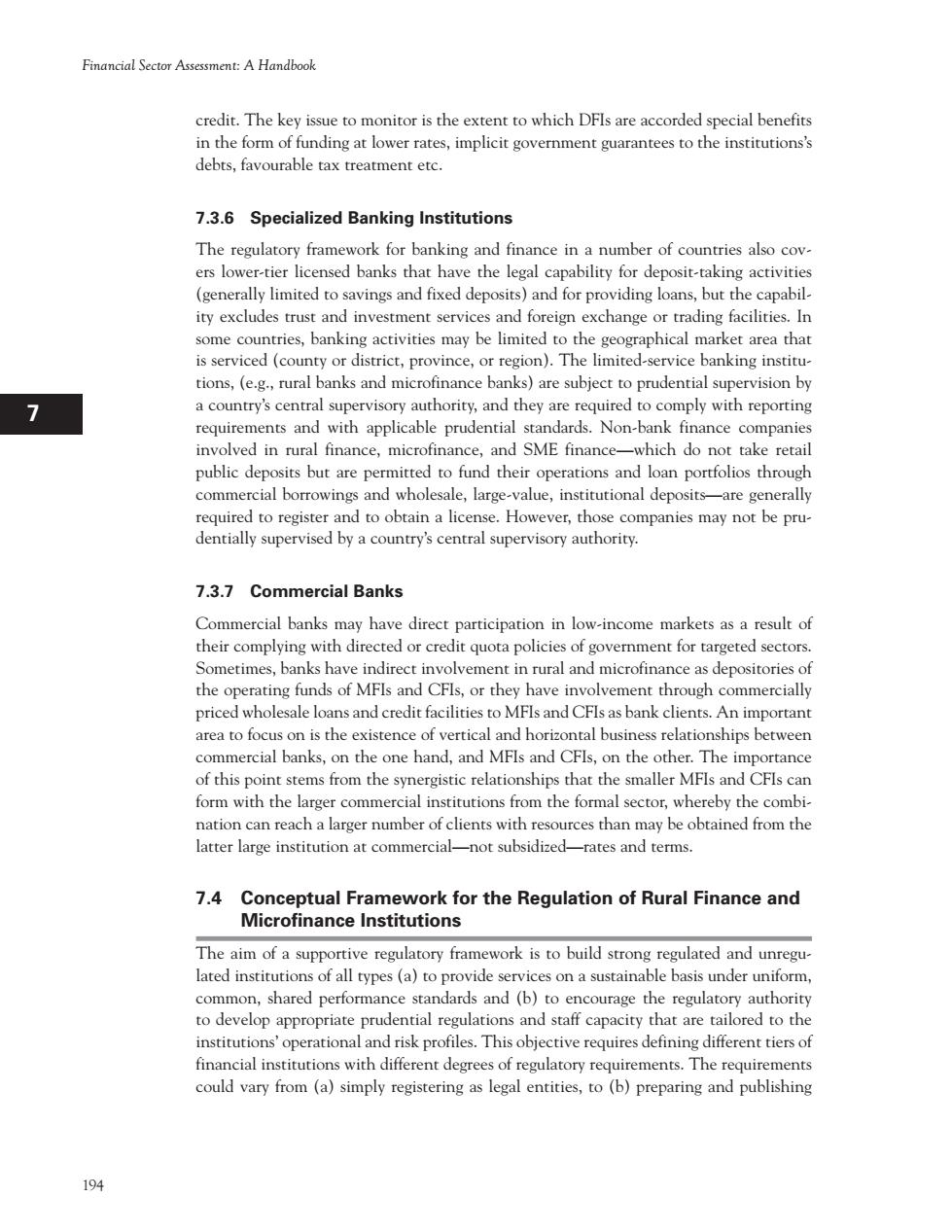正在加载图片...

Financial Sector Assessment:A Handbook credit.The key issue to monitor is the extent towhich DFIs are accorded special benefits in the form of funding at lower rates,implicit government guarantees to the institutions's debts,favourable tax treatment etc. 7.3.6 Specialized Banking Institutions The regulatory framework for banking and finance in a number of countries also cov- ers lower-tier licensed banks that have the legal capability for deposit-taking activities (generally limited to savings and fixed deposits)and for providing loans,but the capabil- ity excludes tus and in ment service sand foreign nge rading faciliti ,banking activities may be limited ion).Th the geographica t area tha is serviced (county or distri ct,province,or re limited-servic tions,(e.g.,rural banks and microfinance banks)are subject to prudential supervision by a country's central supervisory authority,and they are required to comply with reporting requirements and with applicable prudential standards.Non-bank finance companies involved in rural finance microfinance and Sme finance-which do not take rerail public deposits but are permitted to fund their operations and loan portfolios through cial bor wholesale,large value tional dep are red to regis and to obtain a license.However,th iynveibyacontrscenalsupenioyauthori se companies may not be pru 7.3.7 Commercial Banks Commercial banks may have direct participation in low-income markets as a result of their complying with directed or credit quota policies of goverment for targeted sectors. Sometimes.hanks have indirect involvement in rural and microfinance as depositories of the operating funds of mels and cels or they have involyement through commercially priced wholesale loans and credit facilities to MFIs and CFIs as bank clients.An important area to focus on is the existence of vertical and horizontal busine ss relationships betweer nercial banks,on the one hand,and MFIs and on the of this point stemsfrom the synergistic relationships that the smaller CFls can form with the larger commercial institutions from the formal sector,whereby the comb nation can reach a larger number of clients with resources than may be obtained from the latter large institution at commercial-not subsidized-rates and terms. 7.4 Conceptual Framework for the Regulation of Rural Finance and Microfinance Institutions lated of all types (a)topro vide se on a sustainable basis under uniforr and (b)to ntial regulat oencourage the regular ry autho ns and staff capacity that are ta lored to th institutions'operational and risk profiles.This objective requires defining different tiers of financial institutions with different degrees of regulatory requirements.The requirements could vary from (a)simply registering as legal entities,to (b)preparing and publishing 194194 Financial Sector Assessment: A Handbook 1 I H G F E D C B A 12 11 10 9 8 7 6 5 4 3 2 credit. The key issue to monitor is the extent to which DFIs are accorded special benefits in the form of funding at lower rates, implicit government guarantees to the institutions’s debts, favourable tax treatment etc. 7.3.6 Specialized Banking Institutions The regulatory framework for banking and finance in a number of countries also covers lower-tier licensed banks that have the legal capability for deposit-taking activities (generally limited to savings and fixed deposits) and for providing loans, but the capability excludes trust and investment services and foreign exchange or trading facilities. In some countries, banking activities may be limited to the geographical market area that is serviced (county or district, province, or region). The limited-service banking institutions, (e.g., rural banks and microfinance banks) are subject to prudential supervision by a country’s central supervisory authority, and they are required to comply with reporting requirements and with applicable prudential standards. Non-bank finance companies involved in rural finance, microfinance, and SME finance—which do not take retail public deposits but are permitted to fund their operations and loan portfolios through commercial borrowings and wholesale, large-value, institutional deposits—are generally required to register and to obtain a license. However, those companies may not be prudentially supervised by a country’s central supervisory authority. 7.3.7 Commercial Banks Commercial banks may have direct participation in low-income markets as a result of their complying with directed or credit quota policies of government for targeted sectors. Sometimes, banks have indirect involvement in rural and microfinance as depositories of the operating funds of MFIs and CFIs, or they have involvement through commercially priced wholesale loans and credit facilities to MFIs and CFIs as bank clients. An important area to focus on is the existence of vertical and horizontal business relationships between commercial banks, on the one hand, and MFIs and CFIs, on the other. The importance of this point stems from the synergistic relationships that the smaller MFIs and CFIs can form with the larger commercial institutions from the formal sector, whereby the combination can reach a larger number of clients with resources than may be obtained from the latter large institution at commercial—not subsidized—rates and terms. 7.4 Conceptual Framework for the Regulation of Rural Finance and Microfinance Institutions The aim of a supportive regulatory framework is to build strong regulated and unregulated institutions of all types (a) to provide services on a sustainable basis under uniform, common, shared performance standards and (b) to encourage the regulatory authority to develop appropriate prudential regulations and staff capacity that are tailored to the institutions’ operational and risk profiles. This objective requires defining different tiers of financial institutions with different degrees of regulatory requirements. The requirements could vary from (a) simply registering as legal entities, to (b) preparing and publishing